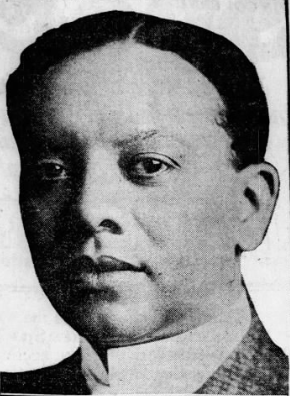Louis B. Anderson facts for kids
Quick facts for kids
Louis B. Anderson
|
|
|---|---|

Alderman Anderson depicted in the Chicago Tribune, 1921
|
|
| Alderman of the Chicago City Council | |
| In office 1917–1933 Serving with Hugh Norris (1917–1918)
Robert R. Jackson (1918–1923) |
|
| Preceded by | Oscar Stanton De Priest |
| Succeeded by | William L. Dawson |
| Constituency | 2nd ward |
| Personal details | |
| Born | April 17, 1870 Petersburg, Virginia, U.S. |
| Died | May 28, 1946 (aged 76) Chicago, Illinois, U.S. |
| Political party | Republican |
Louis Bernard Anderson (born April 17, 1870 – died May 28, 1946) was an American politician. He served as an alderman for Chicago's 2nd ward from 1917 to 1933. An alderman is like a city council member who represents a specific area, called a ward. Anderson was a Republican. He represented the Douglas community area, including much of the African-American neighborhood of Bronzeville. He was a strong supporter of Mayor William Hale Thompson and helped lead his plans in the City Council during the 1920s.
Contents
Louis Anderson's Early Life
Louis Anderson was born on April 17, 1870, in Petersburg, Virginia. In 1889, he moved to Washington, D.C., to work as a journalist. He later moved to Chicago in 1892 to help Moses P. Handy, who was promoting the World's Columbian Exposition.
After this, Anderson worked for Buffalo Bill's Wild West Show. He then returned to Chicago and studied law at Chicago-Kent College of Law, graduating in 1897. He became friends with Robert S. Abbott. Anderson helped Abbott start the Chicago Defender newspaper. He also worked as an attorney for the city.
Louis Anderson's Political Career
Becoming a Chicago Alderman
In 1917, Louis Anderson was elected to represent Chicago's 2nd ward. He was a Republican. He became the second African-American alderman in Chicago's history. His predecessor, Oscar Stanton De Priest, had left office. Anderson won the election and joined fellow Republican Hugh Norris in representing the 2nd ward.
Working with Mayor Thompson
Throughout the 1920s, Anderson was a key supporter of Mayor William Hale Thompson. Mayor Thompson, also known as "Big Bill," was very popular with Chicago's African-American community. Anderson served as Thompson's main leader in the City Council.
In 1921, when a newspaper editor asked Mayor Thompson about problems in the 2nd ward, Anderson defended the mayor. He said that if there were any issues, people should bring proof to the authorities.
In 1922, Anderson had a house built at 3800 S. Calumet. The area around this house later became known as Bronzeville. Also in 1922, Anderson was part of a committee looking into the activities of the Ku Klux Klan in the city. He and two other aldermen reported receiving threats.
Later Political Years
In 1923, Chicago's wards were reorganized. Anderson kept his 2nd ward seat. He won re-election that year, defeating several opponents.
When Democrat William Emmett Dever became mayor in 1923, Anderson disagreed with some of his plans. Anderson believed that changes to city jobs would harm current workers. In 1924, he was a delegate at the 1924 Republican National Convention.
When Mayor Thompson returned to office in 1927, it was thought Anderson would get a major leadership role. However, other aldermen worked to prevent this.
In the 1931 election, Anderson ran unopposed. However, in the mayoral election that year, he stopped supporting Mayor Thompson. Thompson's popularity had dropped. Thompson lost the election to Democrat Anton Cermak. Even though Anderson had stopped supporting Thompson, the 2nd ward still voted for Thompson. Because Anderson had campaigned against him, Mayor Cermak removed Anderson from an important committee.
Anderson did not run for re-election in 1933. He was succeeded by William L. Dawson. In 1936, Anderson ran for a seat in the United States House of Representatives but did not win.
Louis Anderson's Personal Life
Louis Anderson was a partner in a film company called Anderson-Watkins Film Co. In 1913, they made a film called A Day at Tuskegee. Anderson was married to Julia E. Anderson until she passed away in 1931. He later married Oneita Starks in 1933, and they remained married until his death.
Louis Anderson passed away in his Chicago home on May 28, 1946, after being ill. Services were held on June 1.
See also
- List of Chicago aldermen since 1923

